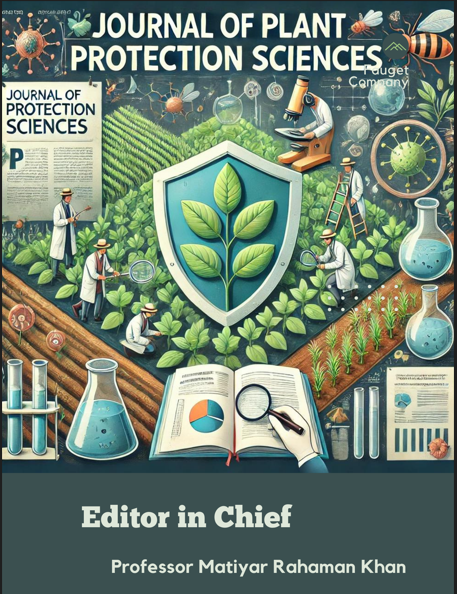Mass production, formulation, quality control and delivery of Trichoderma for plant disease management
DOI:
https://doi.org/10.48165/Keywords:
Trichoderma, mass production, formulation quality control, registration delivery, shelf-life, disease managementAbstract
Trichoderma has gained maximum attention as biocontrol agent due to the fact that it is effective against a large number of soil-borne plant pathogenic fungi, suppressive effects on some root nematodes without adversely affecting beneficial microbes like Rhizobium and capable of promoting growth of certain crops. There are two major methods of inoculum production of Trichoderma spp. viz., solid state fermentation and liquid state fermentation. In solid fermentation, the fungus is grown on various cereal grains, agricultural wastes and byproducts. The solid state production is highly labour intensive and fit for cottage industry. These products are used mainly for direct soil application in nurseries/main fields to suppress the soil-borne inoculum. In liquid state fermentation, Trichoderma is grown in inexpensive media like molasses and yeast medium in deep tanks on a commercial scale. Biomass from the liquid fermentation can be made into different formulations like, dusts, granules, pellets, wettable powders. Trichoderma formulations can be applied to the seed either by dry seed treatment or by seed biopriming for control of several soil-borne diseases of some field crops. Similarly, seedlings of horticultural crops and rice are treated by dipping the roots in Trichoderma suspensions before planting. Granular or pellets preparations and Trichoderma enriched FYM have been used for soil application directly and have provided effective control of diseases both nurseries and field conditions. To ensure that the products of Trichoderma do not affect the environment, human beings and other living organisms adversely and to prevent the sale of poor quality products to the farmers, the Central Insecticide Board of Government of India has made registration of microbial pesticides mandatory before commercial production/import/sale. Guidelines and data requirements for registration of microbial pesticides have been provided in the annexure of Insecticide Act. Quality control parameters set by CIB are inadequate for knowing potentiality of a bioagent. Apart from the counts of live propagules in the formulation, bioefficacy also should be taken as a quality parameter to ensure availability of better products to farmers.
References
Baby, U.I. & Manibhushanrao, K. (1996). Fungal antagonists and VA mycorrhizal fungi for biocontrol of Rhizoctonia solani, the rice sheath blight pathogen, pp. 1-9. In Recent Developments in Biocontrol of Plant Pathogens (Eds. Manibhushanrao, K. & Mahadevan, A.). Today and Tomorrow's Printers and Publishers, New Delhi, 160 pp.
Batta, Y.A. (2005). Postharvest biological control of apple gray mold by Trichoderma harzianum Rifai formulated in an invert emulsion. Crop Protection, 23(1), 19-26.
Bhai, R.S., Thomas, J., & Naidu, R. (1994). Evaluation of carrier media for field application of Trichoderma spp. in cardamom growing soils. Journal of Plantation Crops, 22(1), 50-52.
Connick, W.J., Boyette, C.D., & McAlpine, J.R. (1991). Formulation of mycoherbicides using a pasta-like process. Biological Control, 1, 281-287.
Conway, K.E. (1986). Use of fluid drilling gels to deliver biological control agents to soil. Plant Diseases, 70, 835-839.
Cook, R.J. & Baker, K.F. (1983). The Nature and Practice of Biological Control of Plant Pathogens. APS Books, St. Paul, MN, USA, 539 pp.
Fravel, D.R., Marois, J.J., Lumsden, R.D., & Connick, W.J. (1985). Encapsulation of potential biocontrol agents in an alginate-clay matrix. Phytopathology, 80, 996.
Gopalakrishnan, C., Ramanujam, B., Prasad, R.D., & Rao, N.S., Rabindra, R.J. (2003). Use of brewer's yeast amended spent malt as substrate for mass production of Trichoderma. Journal of Biological Control, 23, 167-170.
Harman, G.E. & Kubicek, C.P. (Eds.) (1998). Trichoderma and Gliocladium, Vol. 1 & 2. Taylor and Francis, London, 278 pp.
Jayaraj, J. & Ramabadran, R. (1996). Evaluation of certain organic substrates and adjuvants for the mass multiplication of Trichoderma harzianum Rifai. Journal of Biological Control, 10, 129-131.
Jeyarajan, R., Ramakrishnan, G., Dinakaran, D., & Sridar, R. (1994). Development of products of Trichoderma viride and Bacillus subtilis for biocontrol of root rot diseases, pp. 25-36. In Biotechnology in India (Ed. Dwivedi, B.K.). Bioved Research Society, Allahabad.
Jeyarajan, R. (2006). Prospects of indigenous mass production and formulation of Trichoderma, pp. 74-80. In Current Status of Biological Control of Plant Diseases Using Antagonistic Organisms in India (Eds. Rabindra, R.J. & Ramanujam, B.). Project Directorate of Biological Control, Bangalore, 445 pp.
Kousalya, Gangadharan, & Jeyarajan, R. (1990). Mass multiplication of Trichoderma spp. Journal of Biological Control, 4, 70-71.
Kumar, A. & Marimuthu, T. (1997). Decomposed coconut coir pith – a conducive medium for colonization of Trichoderma viride. Acta Phytopathologica et Entomologica Hungarica, 32, 51-58.
Lewis, J.A., Papavizas, G.C., & Lumsden, R.D. (1991). A new formulation system for the application of biocontrol fungi to the soil. Biocontrol Science and Technology, 1(1), 59-69.
Mukherjee, P.K. & Mukhopadhyay, A.N. (1995). In situ mycoparasitism of Gliocladium virens on Rhizoctonia solani. Indian Phytopathology, 48(1), 101-102.
Nelson, M.E. & Powelson, M.L. (1988). Biological control of grey mold of snap beans by Trichoderma hamatum. Plant Disease, 72, 727-729.
Papavizas, G.C. & Lewis, J.A. (1989). Effect of Gliocladium and Trichoderma on damping off and blight of snap bean caused by Sclerotium rolfsii in the greenhouse. Plant Pathology, 38, 277-286.
Papavizas, G.C. (1985). Trichoderma and Gliocladium: Biology and potential for biological control. Annual Review of Phytopathology, 23, 23-54.
Prasad, R.D., Rangeshwaran, R., Anuroop, C.P., & Phanikumar, P.R. (2002). Bioefficacy and shelf life of conidial and chlamydospore formulation of Trichoderma harzianum. Journal of Biological Control, 16, 145-148.

